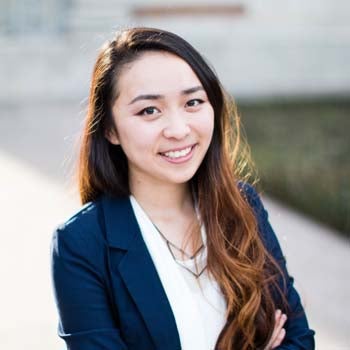Majors: Biological Sciences and Visual and Dramatic Arts
Research Advisor: Joanna Jankowsky, Baylor College of Medicine
Kira Chen ’19 is huddled over a large, white microscope. She is seated at a typical lab desk, orderly and clean. On the surface, there is nothing unique about this image. Chen could be at any lab space in the world, but what makes this one special is what she is looking at. Peering into the ocular lens, Chen is analyzing something incredible: a web of neurons. Thanks to high-powered fluorescence microscopes, scientists are now able to view webs of neurons and image whole planes of a sample layer by layer. Chen uses this type of microscope to image neurons stained with green fluorescent proteins, which light up when a certain cell expresses a desired trait. This results in a beautiful image: what looks like neon roots of a tree system, spreading out and all interconnected.
Chen works with Joanna Jankowsky in the Department of Neuroscience at Baylor College of Medicine, focusing on the pathogenesis of Alzheimer’s disease, the major cause of dementia in middle-aged and elderly people. Jankowsky’s group studies the onset and progression of Alzheimer’s disease and explores possible therapeutic treatments. They use mice as a model system to reproduce certain symptoms of the disease in order to better understand the underlying biology of Alzheimer’s disease.
Amyloid plaques, one of the hallmarks of Alzheimer’s disease, are formed when amyloid-beta peptides clump together, effectively blocking synapses and impairing neuron connections. As part of Jankowsky’s group, Chen is helping to determine how amyloid-beta leads to the cognitive decline of Alzheimer’s disease. One of Chen’s main tasks is producing images of mouse brain slices where amyloid plaques are present. After being treated with different compounds, the parts of the mouse brain that accumulate amyloid plaque glow due to the activation of green fluorescent dyes. Chen uses a microscope to focus on different parts of the brain affected by amyloid and produces images for display and further study.
It was a serendipitous turn of events that led to Chen working in this lab. “When I originally applied [for a lab position], the project description was about worms,” Chen said. She and another applicant were the top two choices for the spot. In order to work with both students, Chen was instead given this project working with mice. “When I was in high school,” she said, “Alzheimer’s disease was always one of the topics I wanted to research. So it’s really cool that I get to do something that my high school self wanted to do.”
This newly assigned project proved to be an especially good fit for Chen, who has been interested in the arts since high school and is pursuing a double major in biological sciences and visual and dramatic arts. As a premed student, she has struggled at times to find the balance between taking art classes and remaining a competitive STEM student. With her research in the Jankowsky Lab, she managed to find a project that combined her love of art and her passion for science.
In Chen’s work, art and science meet both in the imaging of expressive neural webs and in the communication of the importance of her research. “[The intersection is] most obvious in the microscopy images part of my research. It’s also apparent when you publish your research. Not only are you actually publishing the hard results, but the way you talk about the results and present the data — the images, graphs, and diagrams you use — you need to make sure it communicates what you want it to.”
Chen plans to continue conducting research with Jankowsky during her remaining years at Rice and hopes to attend medical school. She is overjoyed that she is contributing to the work being done to understand Alzheimer’s disease. This, combined with the sense of family she finds in the lab, provides an experience Chen greatly enjoys. Of her future in the lab, she said, “It’s not just the research I’m doing but the people I’m doing it with that makes me want to stay in this lab.”

